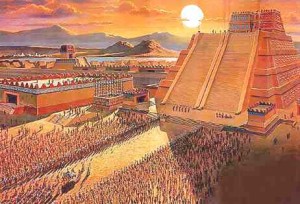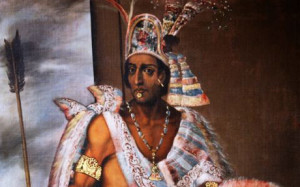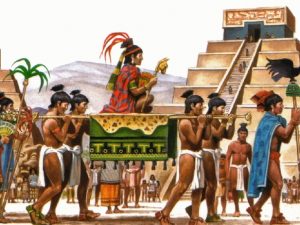Facts about Aztecs Culture
The Aztec empire thrived for just 100 years before it was crushed by Spanish conquerers. But during that time, the Aztecs developed a culture whose mix of wealth and bloodlust still holds our fascination.
500 to 700 people had to die each year in order to appease the gods. The majority were prisoners of war.
In 1980, 42 child skeletons were found near the big temple. Children were sacrificed in times of drought, as their tears were thought to bring rain.
Priests would strip the skin from sacrifices and wear it for 20 days in honor of XipeTotec, the fertility god.
Aztec mythology held that the creator god, the Feathered Snake, would return in 1519. When the Spanish arrived that year, the Aztecs thought that Hernán Cortés was the anticipated god.
 The invading army consisted of only 500 soldiers and 100 sailors. But the horses, weapons and tactics of the Spanish gave them an edge.
The invading army consisted of only 500 soldiers and 100 sailors. But the horses, weapons and tactics of the Spanish gave them an edge.
8,000 men were members of the Aztec army. When on the march, the line stretched some 15 miles long.
25% of all Aztecs died of smallpox, brought to the area by the Spanish. The disease had not been present in Mexico, so the Aztecs had no resistance.
The last of the true Aztec emperors, Moctezuma II, died in 1520, having been humiliated by the Spanish. In 1521, the last of the resistance was defeated.
 The Aztec solar calendar divided the year into 18 months of 20 days each. That accounted for only 360 days — the last five were considered particularly unfortunate.
The Aztec solar calendar divided the year into 18 months of 20 days each. That accounted for only 360 days — the last five were considered particularly unfortunate.
Archaeologists have found more than 7,000 Aztec objects, from decorated skulls to earthenware pots, while excavating the ancient temple area.
The stones that the Aztecs used to build their temples weighed up to 44 tons.
A body of laws from the city of Tetzcoco contained 80 laws and punishments. Strangulation was the standard punishment for theft.
 40,000 to 50,000 buyers and sellers congregated every day in the large marketplace outside the capital. Judges authorized to sentence people to death ensured that order was kept.
40,000 to 50,000 buyers and sellers congregated every day in the large marketplace outside the capital. Judges authorized to sentence people to death ensured that order was kept.
The Aztec empire grew to cover an area of 80,000 square miles (slightly smaller than Kansas) in what is now Mexico.
400 to 500 smaller states were subjugated by the Aztecs over 100 years and forced to pay taxes.
In its heyday, the Aztec empire included 5 to 6 million people.
The capital, Tenochtitlan (now Mexico City), was built on a 7-square-mile island in Lake Texcoco and had 200,000 citizens.
Aztec society
The Aztecs, as well as the North American Iroquois, acted as one nation to all others outside. Each tribe within the confederation was independent of what was involved in local self-government. Each tribe had the advice of the chief and the chief warlord.
All three Aztec tribes participated in the election of the Supreme Aztec War Chief.
Laws were published and written with a pictorial letter. They were strict. Murder and adultery are punished by death.
Aztecs have been educating their children in special schools called calmecac. Education and upbringing of children was one of the main tasks of the clergy.
There was no trade but they held fairs every fifth day. In large cities the crowds of people from various parts of the country came down with agricultural products and handicrafts.
Polygamy is permitted, but is likely to restrict only to the richer class. The Aztecs did not have a caste system, but there was slavery.
Land work and religion
The land belonged to the calpollas (some considered it as clans, or tribes), each calpolla consisted of several calli (or households).
They shared this land together, and the yield of it paid to the state and to the clergy as a tax.
 From the conquered countries Aztecs collected taxes. From various provinces came skin, cocoa, gold, colorful feathers, emeralds, amber, cotton suits and other products. Conquered tribes were obliged to work on public works, as well as the construction of roads or buildings.
From the conquered countries Aztecs collected taxes. From various provinces came skin, cocoa, gold, colorful feathers, emeralds, amber, cotton suits and other products. Conquered tribes were obliged to work on public works, as well as the construction of roads or buildings.
Today, Aztecs are grateful for the chocolate. They made cocoa and vanilla drinks (it grew in limited coastal areas of Mexico) and called it chocolatl, it was foamy, and it was cold.
Aztec religion was polytheistic, the Aztecs have their arrival picked up many elements of other meso-American cultures and the early peoples. The most important role in religious life was Huitzilopochtli, a god of war.
Tonatiuh was the god of the sun. Human sacrifices were offered to the sun, which led to continuous warfare (so-called “war of flowers”) to bring new prisoners. Their hearts will be sacrificed to the sun, the bodies will be broken and distributed to the people to be eaten.
According to the belief of the Aztecs only the souls of warriors who fell in battle were sacrificed and go to heaven. The soul of a woman who died at birth also.
